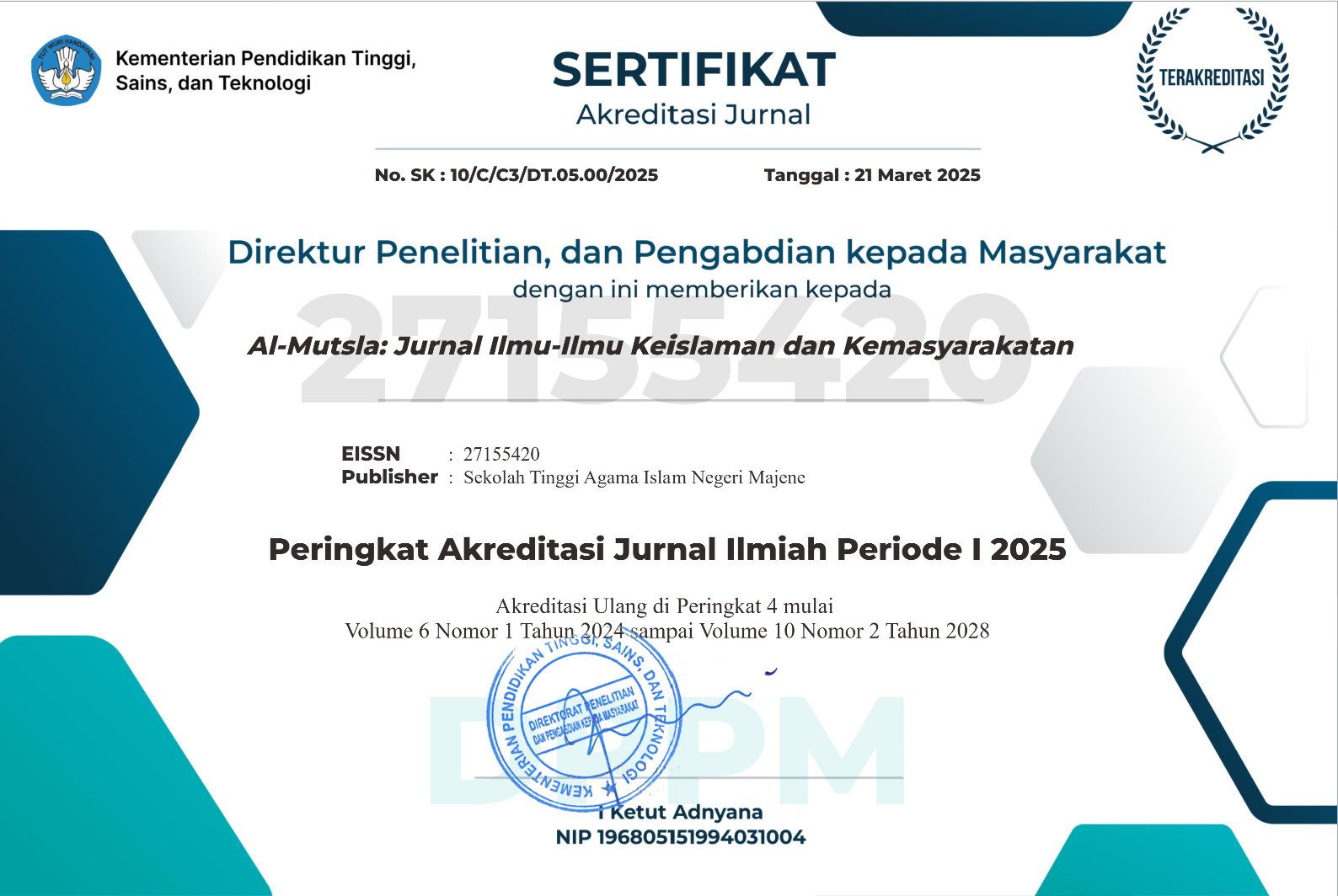Author Guidelines
PROCEDURE FOR WRITING JOURNAL AL-MUSTLA
1. WRITING GUIDELINES
a. Minimum size of the manuscript PDF file is 5 MB
b. Manuscripts are written in Indonesian or English or Arabic with Time New Roman Font 12. The length of the manuscript is about 10-20 pages and typed 1 space.
c. The page settings are 2 columns with equal with columns and the distance between the columns is 5mm, while the title, author's identity and abstract are written in 1 column.
d. The paper size is A4 with a margin of 3.0 cm for the top, bottom and left borders. While the right is 2.0 cm.
2. WRITING SYSTEMS
a. Beginning: Title, author's name and abstract
b. Main parts:
1. Introduction containing background and formulation
2. Research Method
2. Discussion
3. Closing: Conclusions and Suggestions.
c. Final Part: Bibliography
3. TITLE AND AUTHOR'S NAME
a. The title is printed in capital letters, in bold with Times New Roman font 14, single spaced with a maximum number of 12 words, using Indonesian and English.
b. The author's name is written under the title without a title, may not be abbreviated, begins with a capital letter, without starting with the word "by".
c. The name and address of the institution and the email of the author.
4. ABSTRACT
a. Abstract written in Indonesian and English, contains the core problems, research background, writing and the results obtained. The word abstract is in bold, the abstract content does not need to be in bold.
b. The number of words in the abstract is not more than 250 words and is typed 1 space.
c. Abstract font is Times New Roman font 12, presented with left and right alignment, presented in one paragraph, and written without indenting at the beginning of the sentence.
d. Abstract is equipped with keywords consisting of 3-5 words which are the core of the abstract description. Keywords in bold (bold)
5. GENERAL RULES OF TEXT WRITING
a. Each subtitle is written in Times New Roman font 12 and in bold.
b. New paragraphs are written indented with an indent-first line of 0.75 cm, without spaces between paragraphs.
c. Foreign words are written in italics.
d. All numbers are written with numbers, except at the beginning of sentences and integers less than ten must be spelled out.
e. Tables and figures must be clearly explained and numbered sequentially.
6. REFERENCES
Writing literature using the Chicago Style system. Everything listed in the bibliography must be referenced in the manuscript. Up-to-date references are highly preferred.
- Book
- One Author Footnote:
Bagir Manan, Dasar-dasar Perundang-undangan Indonesia, (Jakarta: IND-HILL.CO, 1992), hlm. 3. Malcom N. Shaw, International Law, (Cambridge:Cambridge University Press, 1994), pp. 5-6.
Catatan: Penulisan halaman pada footnote artikel Bahasa Inggris, ‘p.’ Jika menggunakan 1 halaman, dan ‘pp.’ jika lebih dari 1 halaman
Bibiliografy:
Manan, Bagir. Dasar-Dasar Perundang-undangan Indonesia. Jakarta: IND-HILL.CO, 1992.Shaw, Malcolm N. International Law. Cambridge: Cambridge University, 1994.
- Two Author Footnote:
Geoffrey C. Ward and Ken Burns, The War: An Intimate History, 1941-1945, (New York: Knopf, 2007), p. 52.Adami Chazawi dan Ardi Ferdian, Tindak Pidana Informasi & Transaksi Elektronik, (Malang: Bayumedia Publishing, 2011), hlm. 52.
Bibiliografy:
Chazawi, Adami dan Ardi Ferdian. Tindak Pidana Informasi & Transaksi Elektronik. Malang: Bayumedia Publishing, 2011.Ward, Geoffrey C. and Ken Burns. The War: An Intimate History,1941-1945. New York: Knopf, 2007.
- Two or more author Footnote:
Richard M. Buxbaum et al., European Economic and Business Law, 2nd ed., (Germany: de Gruyter, 1996), p. 280.H. Syaukani, dkk, Otonomi Daerah Dalam Negara Kesatuan, (Yogyakarta: Pustaka, 2005), hlm. 14.
Bibiliografy:
Buxbaum, Richard M. et al. European Economic and Business Law. 2nd ed. Germany: de Gruyter, 1996.Syaukani, H. dkk. Otonomi Daerah Dalam Negara Kesatuan.Yogyakarta: Pustaka, 2005.
- Juornal Article
- Journal Article Footnote:
Damilola S. Olawuyi, “Mainstreaming Human Rights under National and International Law: Legal and Epistemic Question,” Indonesia Law Review Year 3, Vol. 3, (September – December 2013):224.
Andriyani Mustika Nurwijayati, “Eksploitasi Anak: Perlindungan Hukum Anak Jalanan Dalam Perspektif Hukum Pidana Di Daerah Yogyakarta”, Jurnal Jurisprudence Vol. 1, No. 1, (Juli 2012):208.
Bibiliografy:
Nurwijayati, Andriyani Mustika. “Eksploitasi Anak: Perlindungan Hukum Anak Jalanan Dalam Perspektif Hukum Pidana Di Daerah Yogyakarta”. Jurnal Jurisprudence Vol. 1, No. 1, (Juli 2012)
Olawuyi, Damilola S. “Mainstreaming Human Rights under National and International Law: Legal and Epistemic Question”. Indonesia Law Review Year 3, Vol. 3, (September – December 2013)
- Journal Article Online Footnote:
Reka Dewantara, “Rekonseptualisasi Asas Demokrasi Ekonomi Dalam Konstitusi Indonesia”, Arena Hukum Vol. 7, No. 2, (Agustus 2014): 195, diakses 16 Agustus 2016, doi: http://dx.doi.org/10.21776/ub.arenahukum.2014.00702.3.
Bibiliografy:
Dewantara, Reka. “Rekonseptualisasi Asas Demokrasi Ekonomi Dalam Konstitusi Indonesia”.Arena Hukum Vol. 7, No. 2, (Agustus 2014): 195. Diakses 16 Agustus 2016. doi:http://dx.doi.org/10.21776/ub.arenahukum.2014.00702.3.
- Surat Kabar
Footnote:
- Bartens, “Aborsi Di Tengah Polarisasi “Pro Life”-“Pro Choice”, Kompas, (11 Oktober 2012): 89.
Rajiv Chandrasekaran, “Amnesty Efforts Lag in Afghanistan”, Washington Post, (19 May 2011): 1.
Bibiliografy:
Bartens, K. “Aborsi Di Tengah Polarisasi “Pro Life”-“Pro Choice”.Kompas. (11 Oktober 2012): 89.
Chandrasekaran, Rajiv. “Amnesty Efforts Lag in Afghanistan”.Washington Post. (19 May 2011): 1.
- d) Skripsi / Thesis / Disertasi
Footnote:
Netty Endrawati, “Perlindungan Hukum Terhadap Pekerja Anak Di Sektor Informal (Studi Kasus Di Kota Kendiri)”, Disertasi Ilmu hukum, Program Pasca Sarjana Dotor Ilmu Hukum, (Surabaya: UNTAG, 2011), Tidak Dipublikasikan, hlm. 13.
Bibiliografy:
Endrawati, Netty. “Perlindungan Hukum Terhadap Pekerja Anak Di Sektor Informal (Studi Kasus Di Kota Kendiri)”. Disertasi Ilmu Hukum Program Pasca Sarjana Dotor Ilmu Hukum. Surabaya: UNTAG, 2011. Tidak Dipublikasikan.
- e) Makalah
Footnote:
Laurensius Arliman S., Penyuluhan Hukum Perlindungan Anak disampaikan di Aula SMA Negeri 6 Kota Padang, (Padang: Sekolah Tinggi Ilmu Hukum Padang, 2015), hlm. 15.
Bibiliografy:
S., Laurensius Arliman. Penyuluhan Hukum Perlindungan Anak disampaikan di Aula SMA Negeri 6 Kota Padang. Padang: Sekolah Tinggi Ilmu Hukum Padang, 2015.
- f) Internet File
Footnote:
Bulent Gokay, “The 2008 World Economic Crisis: Global Shifts and Faultlines”, http://www.globalresearch.ca/the-2008-world-economic-crisis-global-shifts-and- aultlines/12283, accessed 19 November 2009.
Direktorat Pengairan dan Irigasi Bappenas, “Penyelesaian Konflik Sumber Daya Air”, http://perpustakaan.bappenas.go.id/lontar/file?file=digital/114307-%5B_Konten_%5D- M.97.Direk.Pengairan.pdf, diakses 6 Juni 2014.
Bibiliografy:
Direktorat Pengairan dan Irigasi Bappenas. “Penyelesaian Konflik Sumber Daya Air”. http://perpustakaan.bappenas.go.id/lontar/file?file=digit al/114307-%5B_Konten_%5D-M.97.Direk.Pengairan.pdf. Diakses 10 Juni 2015.
Gokay, Bulent. “The 2008 World Economic Crisis: Global Shifts and Faultlines”. http://www.globalresearch.ca/the-2008-world-economic-crisis-global-shifts-and- faultlines/12283. Accessed 19 November 2009.
Footnote:
Pasal 5 Undang-undang Nomor 12 Tahun 2011 tentang Pembentukan Peraturan Perundang- undangan.
Putusan Pengadilan Negeri Jakarta Selatan Nomor: 04/Pid.Prap/2015/PN.Jkt.Sel. tentang Penetapan Tersangka, hlm. 242-243.
Putusan Mahkamah Konstitusi Nomor: 005/PUU-IV/2006, hlm. 83.
Bibiliografy:
Undang-undang Republik Indonesia Nomor 12 Tahun 2011 tentang Pembentukan Peraturan Perundang-undangan.
Putusan Pengadilan Negeri Jakarta Selatan Nomor:04/Pid.Prap/2015/PN.Jkt.Sel. tentang Penetapan Tersangka.
Putusan Mahkamah Konstitusi Nomor: 21/PUU-XII/2014.
Footnote:
Putusan Mahkamah Agung Nomor 680 K/Pid/2013 Tahun 2015.
Daftar Pustaka:
Putusan MAHKAMAH AGUNG Nomor 680 K/Pid/2013 Tahun 2015.
Hasil Wawancara
Footnote:
Wawancara dengan Aipda Aji Lukmansyah, S.H., Anggota Satreskrim Polres Malang Kota, 10 Nopember 2014.









